Clare Francis said:
“Ted Hupp and Kathryn Ball may very well feel like kissing David Argyle on both cheeks.”
That’s because when the pseudonymous image integrity sleuth heard of David Argyle’s bullying and the cover-up by the University of Edinburgh in Scotland, UK, Clare Francis started to screen Argyle’s papers for image irregularities. And soon stumbled over Argyle’s postdoc Lisa Pang, who did her PhD at the Cancer Research UK (CRUK) Edinburg Centre and MRC Institute of Genetics & Molecular Medicine under Ted Hupp, the US-born Edinburgh professor, who proved to be Argyle’s collaborator.
Right away, Clare Francis found a treasure trove of questionable research papers from Hupp’s lab. From Hupp’s papers, the sleuth stumbled upon another Edinburgh professor, Kathryn Ball, and her lab’s papers proved a treasure trove as well!
Hupp and Ball are in fact a husband-and-wife team, they both started together as PhD students at the Michigan State University in USA, moved together as postdocs to Scotland, both to the University of Dundee lab of Sir David Lane (who is now at Karolinska Institutet in Stockholm, Sweden, and not replying to emails). Hupp and Ball then both became professors at the same Institute of Genetics and Cancer by CRUK and MRC in Edinburgh. Both work on cell cycle regulation, he on p53, she on the p21 protein. Both sit on the scientific advisory board of the Scottish biotech startup ILC Therapeutics which seeks to cure with interferon drugs various diseases including COVID-19. Both published, together and separately, Photoshopped stuff they should be deeply ashamed for, and both remained silent when I contacted them.
I want to celebrate this power couple.
Here is how Clare Francis was led to playing the Hupp and Ball game. From Argyle to Pang to Hupp to Ball.
Lisa Y. Pang, Mary Scott , Richard L. Hayward , Hisham Mohammed , C. Bruce A. Whitelaw, Graeme C.M. Smith , Ted R. Hupp p21(WAF1) is component of a positive feedback loop that maintains the p53 transcriptional program Cell Cycle (2011) doi: 10.4161/cc.10.6.15012
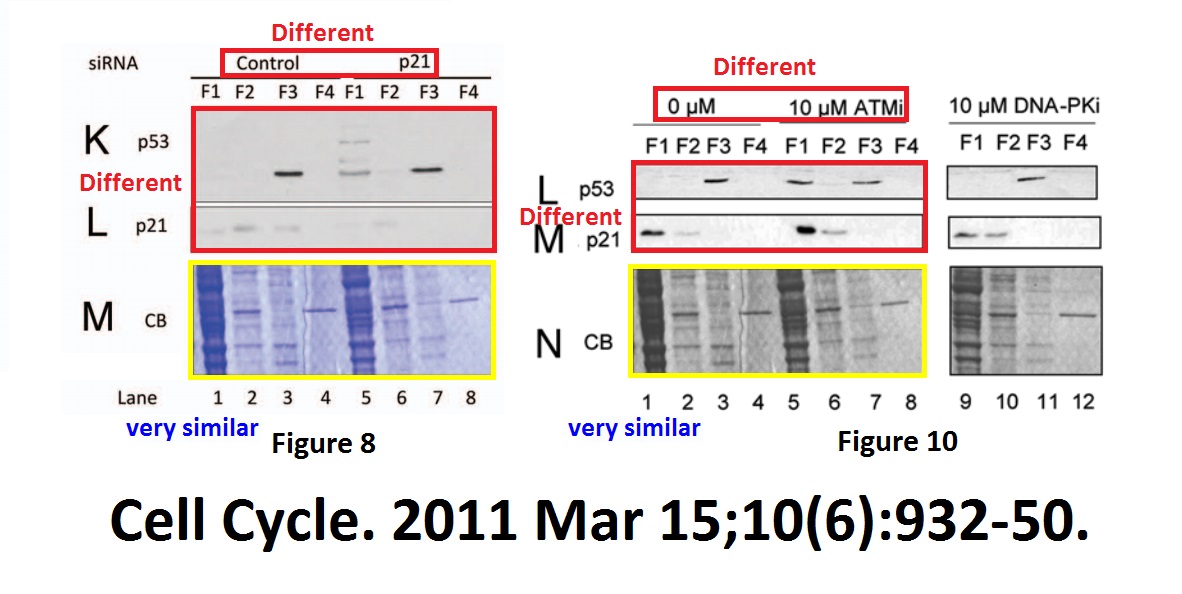
A Ponseau S blot image, “accidentally” reused, once in colour, once black-and-white, for two unrelated experiments. Why couldn’t the correct loading control be used? A mystery.
Here a paper by Hupp and Ball, rather old, raw data unavailable, but even Hupp agrees the gel is falsified:
Ashley Craig , Mary Scott , Lindsay Burch , Graeme Smith , Kathryn Ball, Ted Hupp Allosteric effects mediate CHK2 phosphorylation of the p53 transactivation domain EMBO reports (2003) doi: 10.1038/sj.embor.embor901
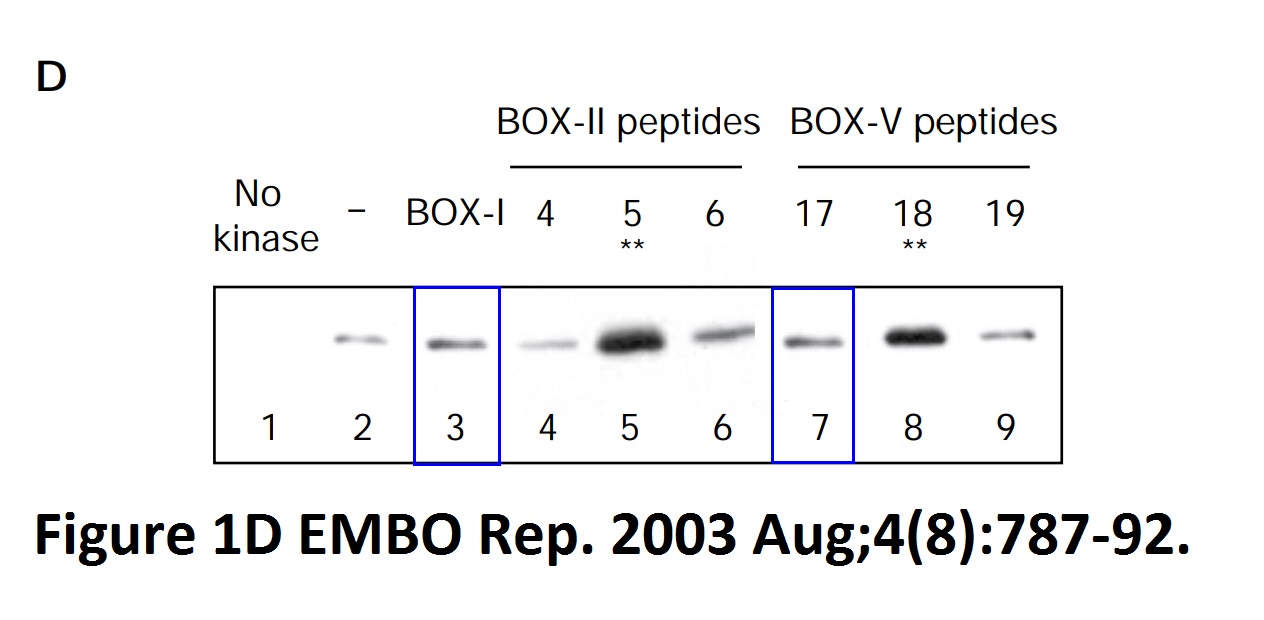
Hupp declared on PubPeer in June 2021:
“The authors think that the apparent similarity resulted from image crop/paste from different gels to condense key data from Fig 1d of the same paper, but the original data are no longer available for analysis. This particular image does not affect the overall data interpretation or the conclusions from the study; regarding stimulation of the chk2 kinase using synthetic peptides (named 5 and 18) that are the best binders to chk2 (fig 1d) so that there is a correlation between binding of peptides to chk2 and chk2 stimulation; the same chk2 stimulatory peptides were also reproduced in other data throughout the paper in question and these same peptides were also used as kinase stimulators reproduced in a follow up study (10.1128/MCB.01595-06) and towards another regulatory protein (10.1016/j.molcel.2006.05.029 ).“
Right-ho. It’s OK to fabricate results if you can reproduce them in your later papers. The first referenced study from Hupp’s lab has a blot duplication and a digitally assembled Chk1 gel, maybe the authors disapproved of the original results.
Ashley L. Craig , Jennifer A. Chrystal , Jennifer A. Fraser , Nathalie Sphyris , Yao Lin , Ben J. Harrison , Mary T. Scott , Irena Dornreiter , Ted R. Hupp The MDM2 ubiquitination signal in the DNA-binding domain of p53 forms a docking site for calcium calmodulin kinase superfamily members Molecular and Cellular Biology (2007) doi: 10.1128/mcb.01595-06
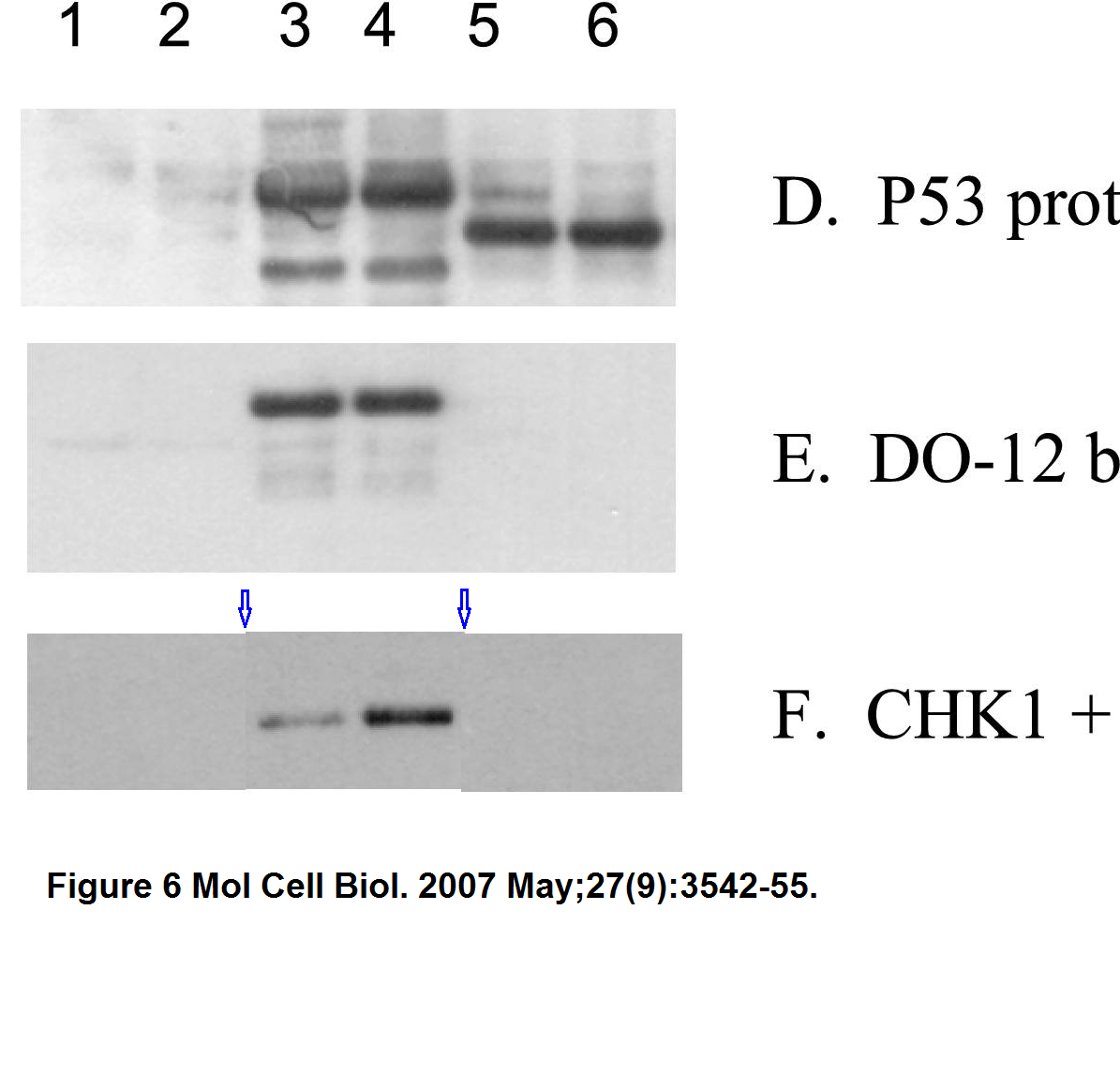
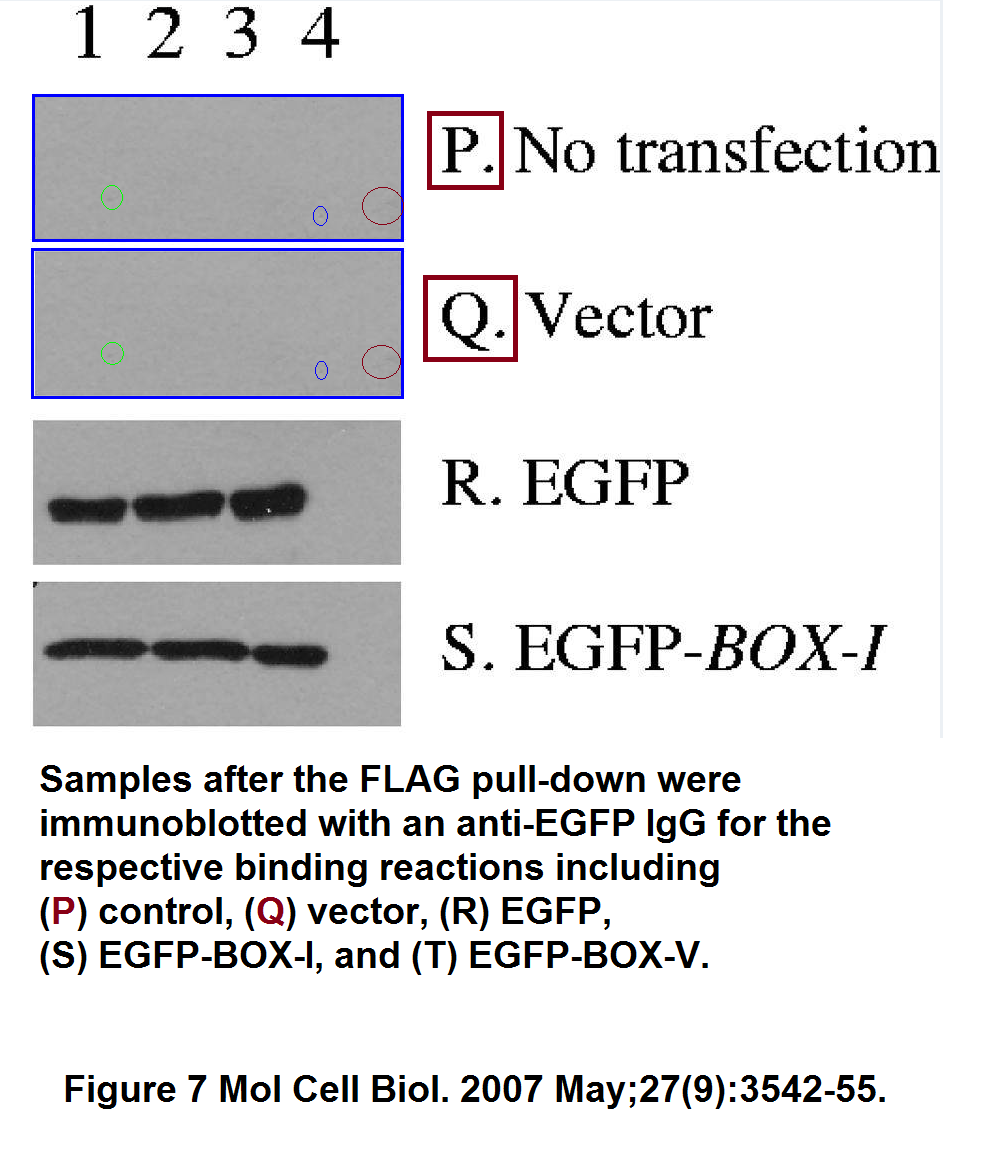
The second referenced paper by Hupp and Ball (Wallace et al 2006) hasn’t been yet commented upon on PubPeer, which under the circumstances of this story is no proof the paper is kosher.
What to make of the next paper though? Does any of this, uhm, reproducibility, affect the conclusions?
David Dornan , Mirjam Eckert , Maura Wallace, Harumi Shimizu, Eleanor Ramsay , Ted R. Hupp, Kathryn L. Ball Interferon regulatory factor 1 binding to p300 stimulates DNA-dependent acetylation of p53 Molecular and Cellular Biology (2004) doi: 10.1128/mcb.24.22.10083-10098.2004
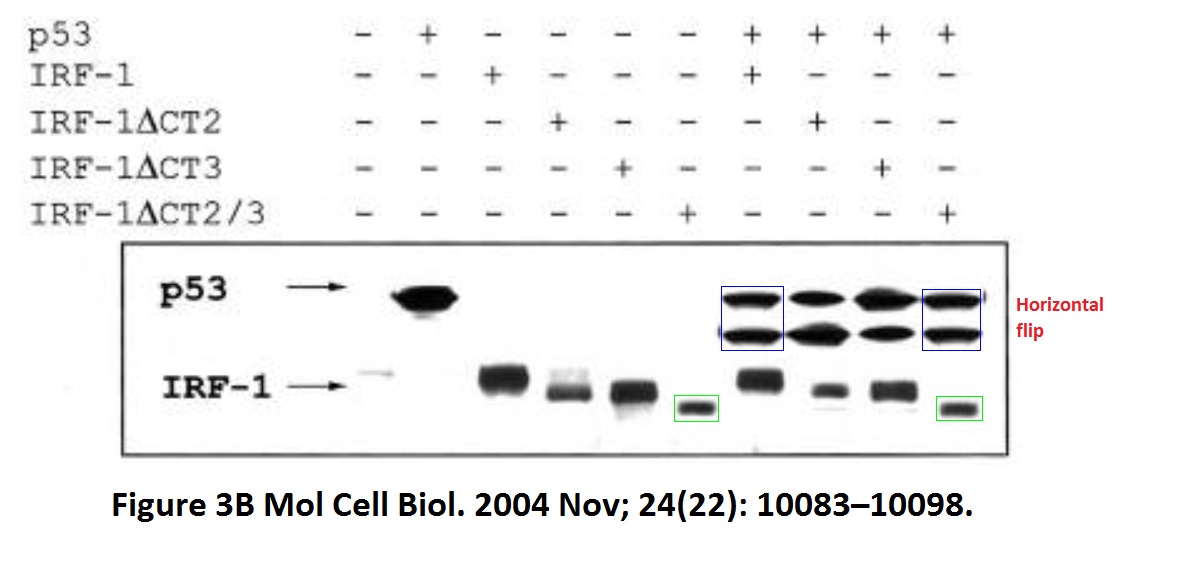

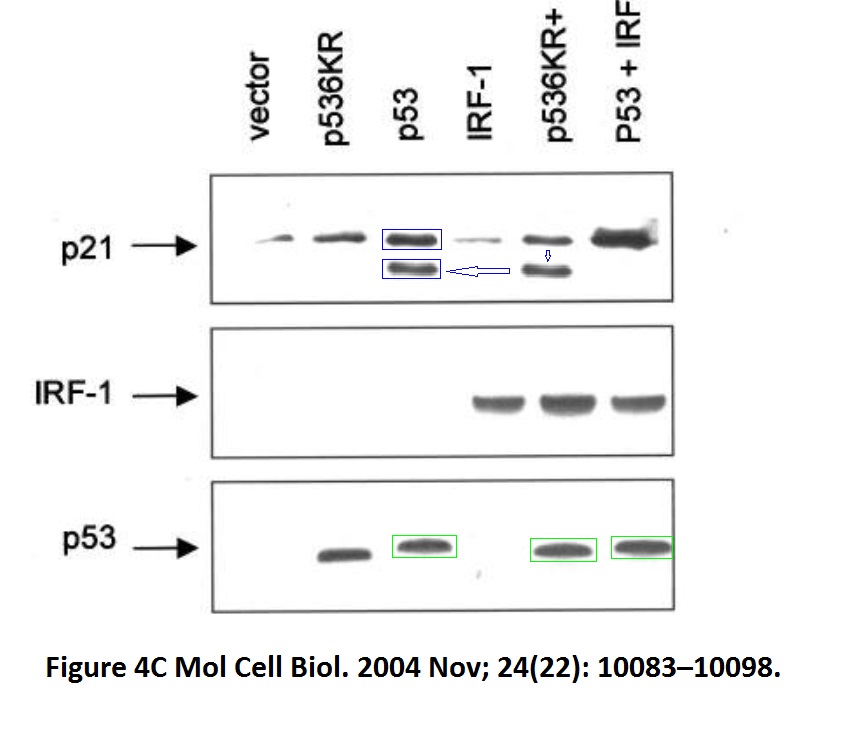
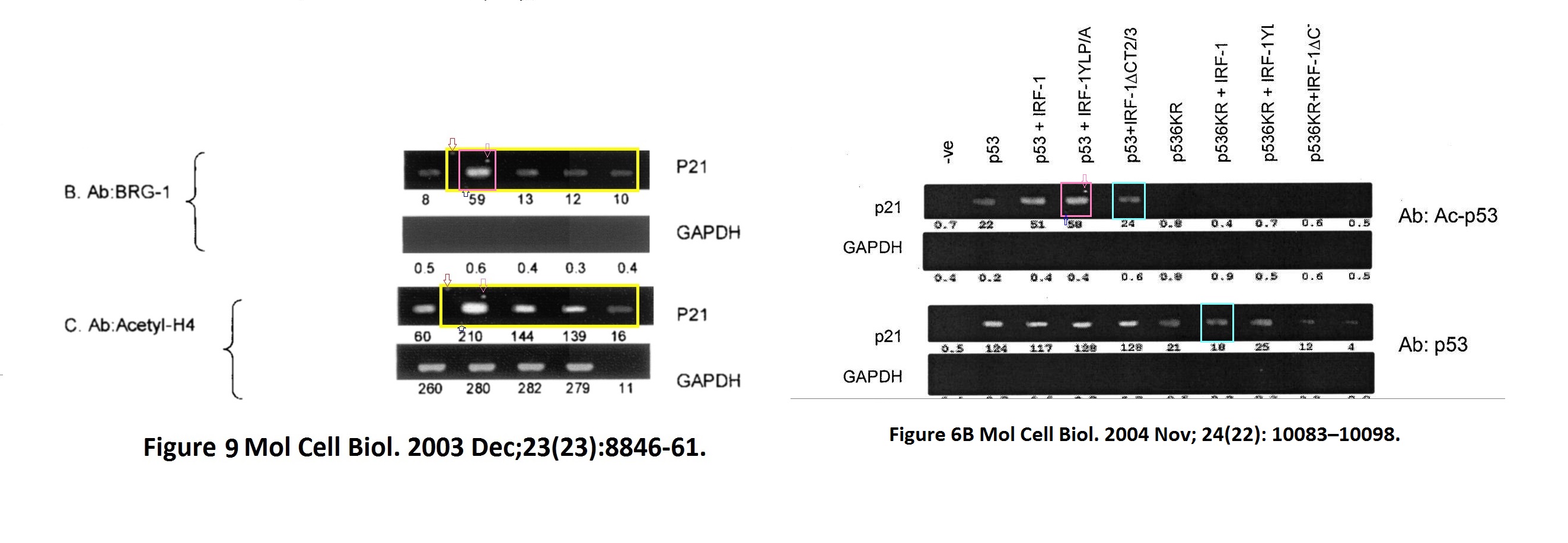

The first author David Dornan is Hupp’s former PhD student and now Chief Scientific Officer of Bolt Therapeutics, where he “is working to harness the exciting technologies at Bolt to discover and develop therapeutics that may exploit myeloid cell biology to generate a robust anti-tumor immune response.” He also didn’t reply to my email, and neither did Bolt.
Here is another example of what Dornan learned in the Hupp lab:
David Dornan , Harumi Shimizu , Lindsay Burch , Amanda J. Smith , Ted R. Hupp The proline repeat domain of p53 binds directly to the transcriptional coactivator p300 and allosterically controls DNA-dependent acetylation of p53 Molecular and Cellular Biology (2003) doi: 10.1128/mcb.23.23.8846-8861.2003
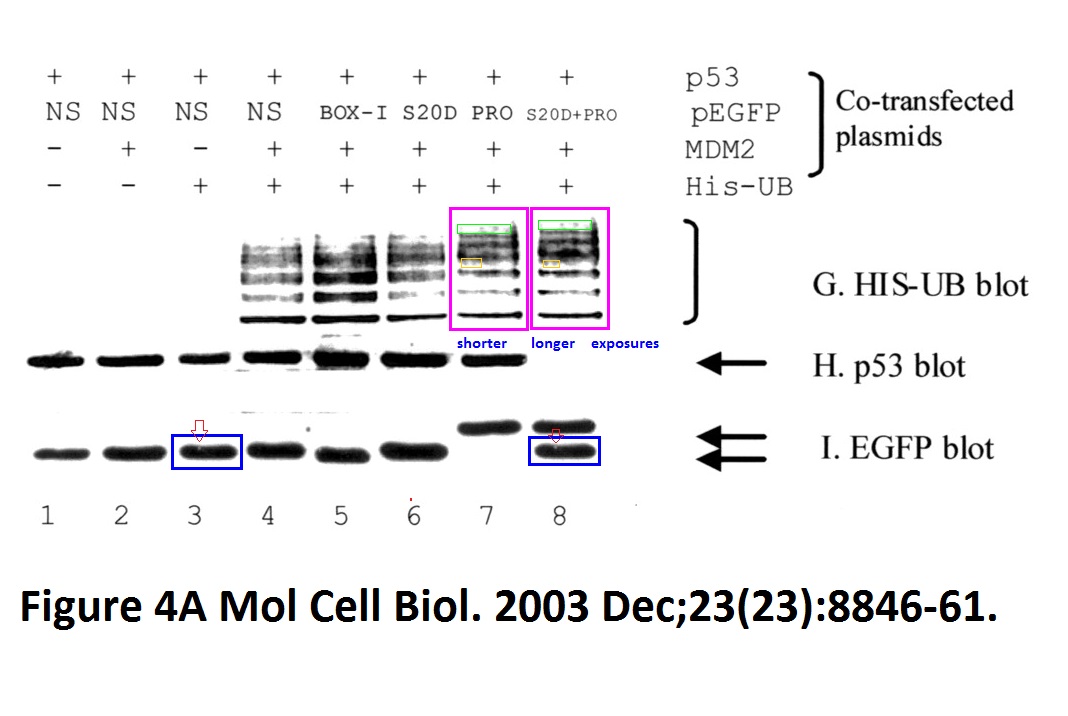
Hupp replied to this finding in June 2021 on PubPeer that yes, the gel is digitally falsified, but it was just a control:
“The authors feel that the apparent similarity likely resulted from mixing images cropped from different gels to assemble the final figure, but the original data could not be retrieved for analysis. This particular image was a negative control and does not affect the overall data interpretation or the conclusions from the study regarding interaction of p300 to proline-derived peptides, including deletion of the proline motifs of p53 that attenuate p300 functions (fig 5/6/7) and proline repeat domain protein promoter recruitment by chromatin ip (fig 8/9). The ability of proline repeat peptides to bind to p300 was also established by other studies (doi; 10.1074/jbc.M210696200; DOI; 10.1074/jbc.275.3.2115; DOI; 10.1016/j.jmb.2005.12.026; 10.1038/onc.2009.71).“
Basically, controls are also there to prove that you didn’t fudge up your experiment to get the result you wanted. Hupp and his mentee Dornan failed the test.
In any case, more was found in the Dornan et al 2003 study:
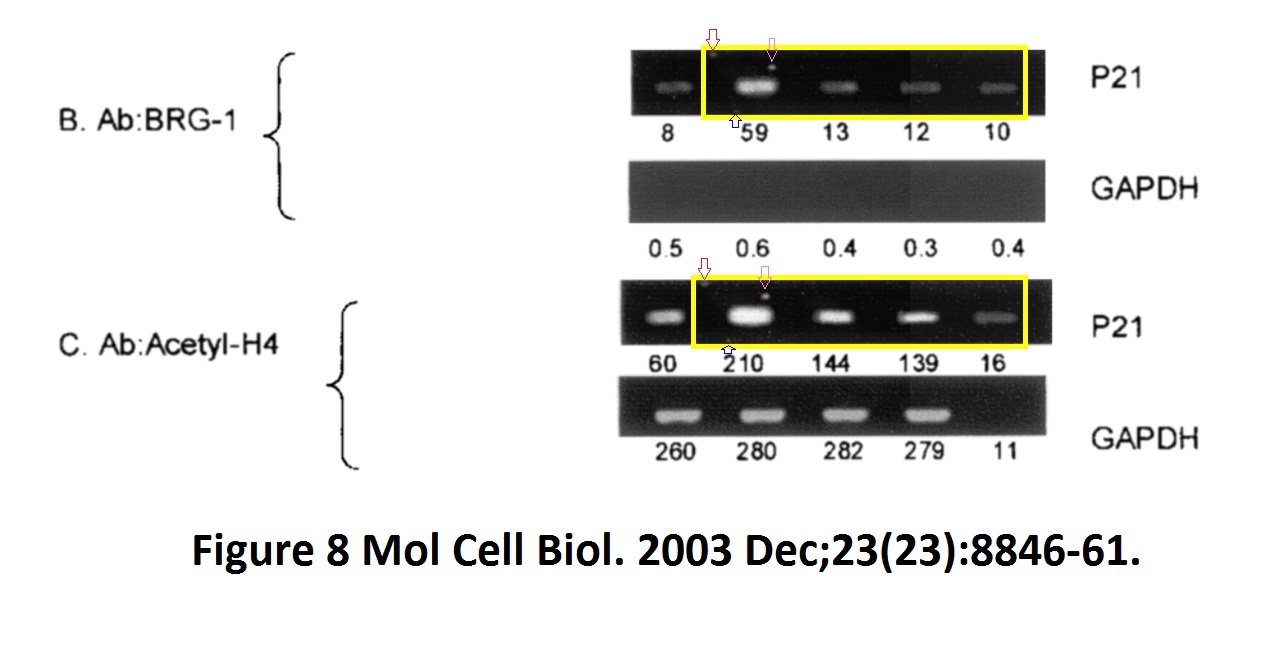
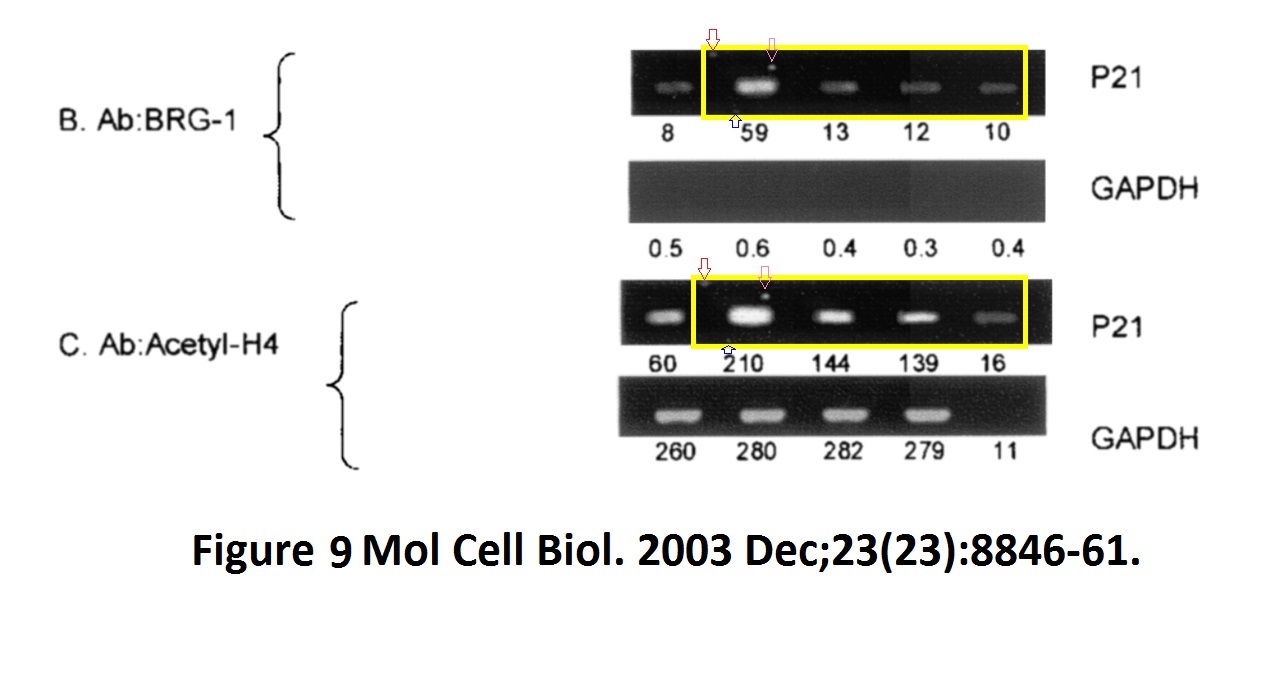
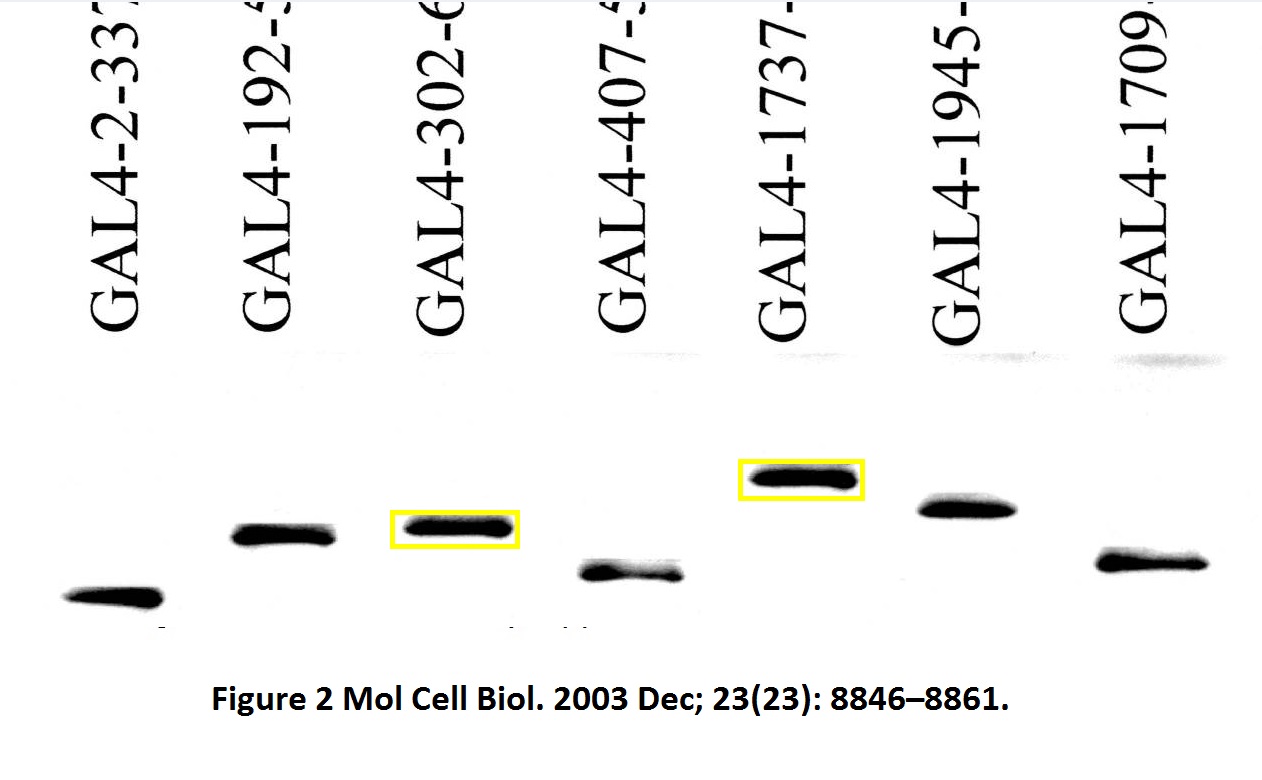

There, Hupp didn’t reply anymore. Also, that Dornan et al 2003 paper shares western blots bands with another Dornan et al 2003 paper:
David Dornan , Harumi Shimizu , Neil D. Perkins , Ted R. Hupp DNA-dependent acetylation of p53 by the transcription coactivator p300 Journal of Biological Chemistry (2003) doi: 10.1074/jbc.m211460200

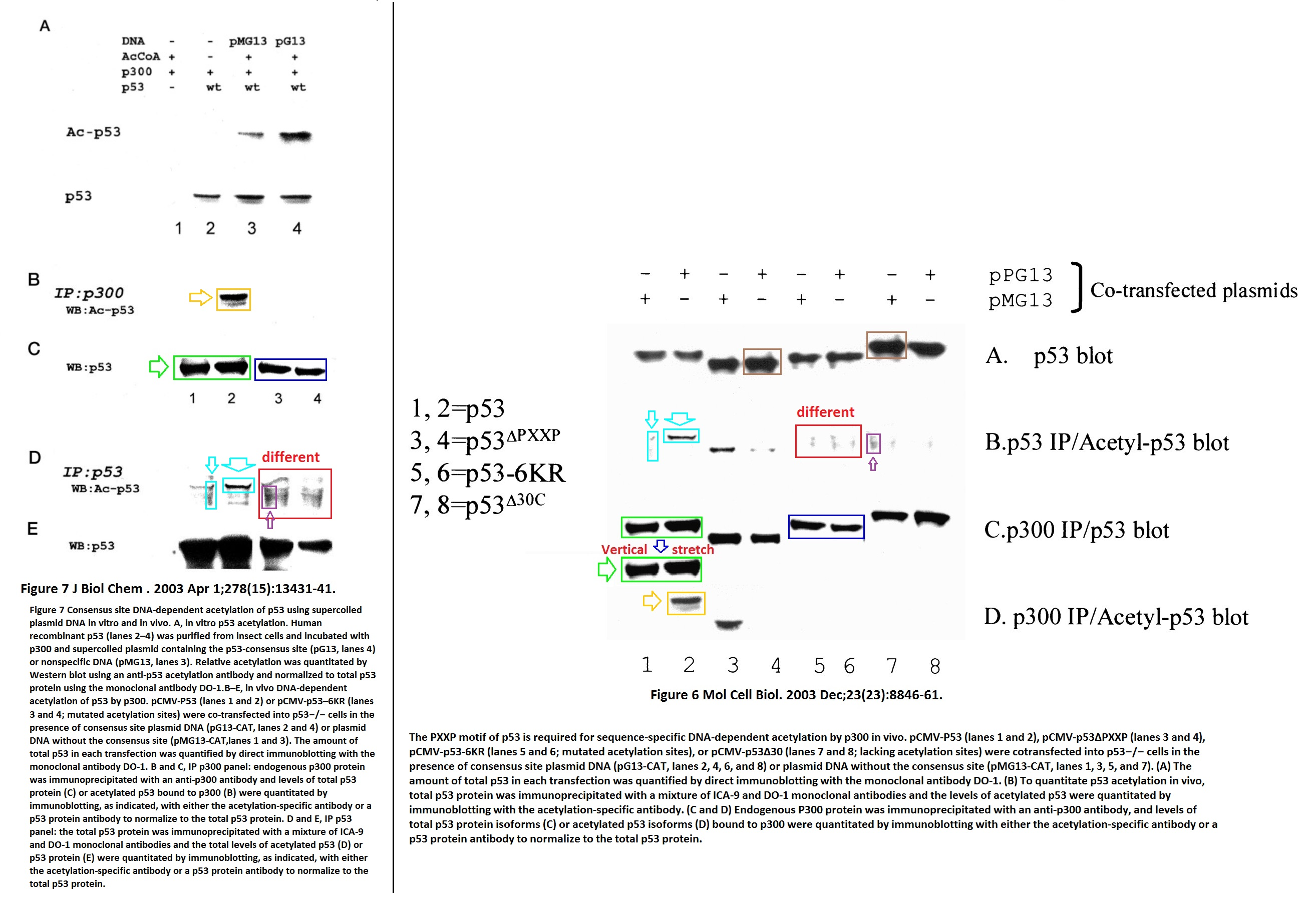
Neil Perkins, now that name rings a bell. Alarm bells, actually. In 2014, Perkins, then with the Wellcome Centre of University of Dundee, retracted 4 papers, and explained in this regard to Retraction Watch that a) his postdoc Benjamin Barré did it and b) he, Perkins, exposed this fraud all by himself (OK, together with Barre’s PhD mentor). However, Perkins had already at that time several other papers flagged on PubPeer, and those were not co-authored by Barré.
Perkins’ academic career trajectory is interesting. Having spent 12 years as Dundee professor, he suddenly had enough and went to University of Bristol in 2008, but stopped being professor there after less than 2 years. Since 2010, Perkins is with University of Newcastle, where he is now deputy dean of biosciences. Meaning, all misconduct allegations in the faculty go through Perkins’ desk.
Between Hupp and Ball, the husband is the bigger academic heavyweight. In 2017, Hupp (together with a French colleague) received €9.5 Million from the Foundation for Polish Science to set up the International Centre for Cancer Vaccine Science at the University of Gdansk. Hupp runs the Centre’s Twitter account, here is his dear collaborator, the bully Argyle, visiting (right):
Any moment now will Dr Hupp’s Photoshop technology produce a cancer vaccine. Now let’s have a look at what Dr Ball’s lab enriched the science with.
Mary T Scott , Angela Ingram , Kathryn L Ball PDK1-dependent activation of atypical PKC leads to degradation of the p21 tumour modifier protein The EMBO Journal (2002) doi: 10.1093/emboj/cdf684
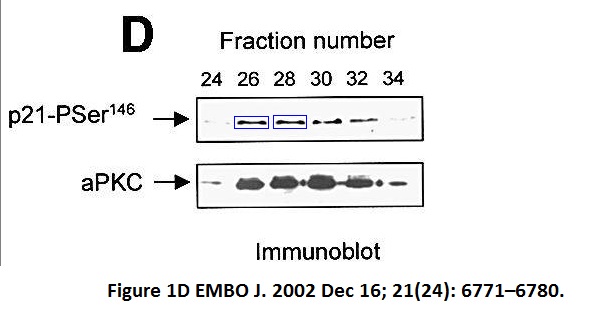
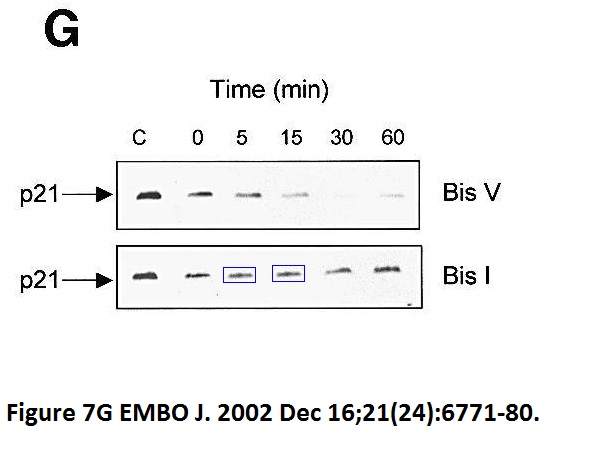
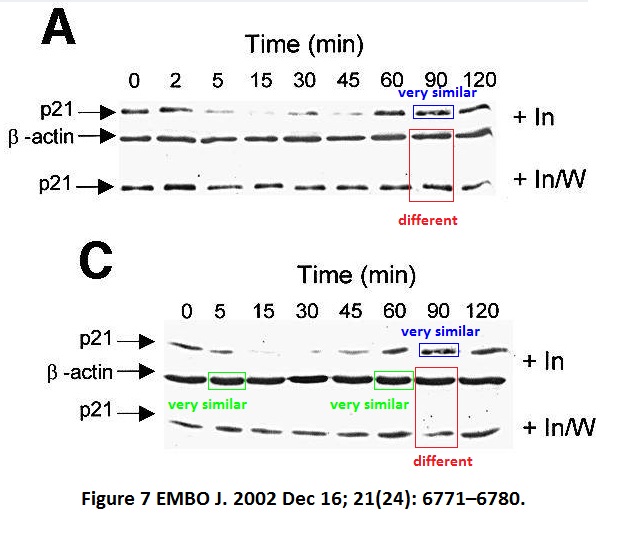
Maura Wallace used to head a unit at University of Edinburgh, a local newspaper once celebrated her receiving a charity donation for her cancer research. The charity money was put to good use.
Maura Wallace, Kathryn L. Ball Docking-dependent regulation of the Rb tumor suppressor protein by Cdk4 Molecular and Cellular Biology (2004) doi: 10.1128/mcb.24.12.5606-5619.2004

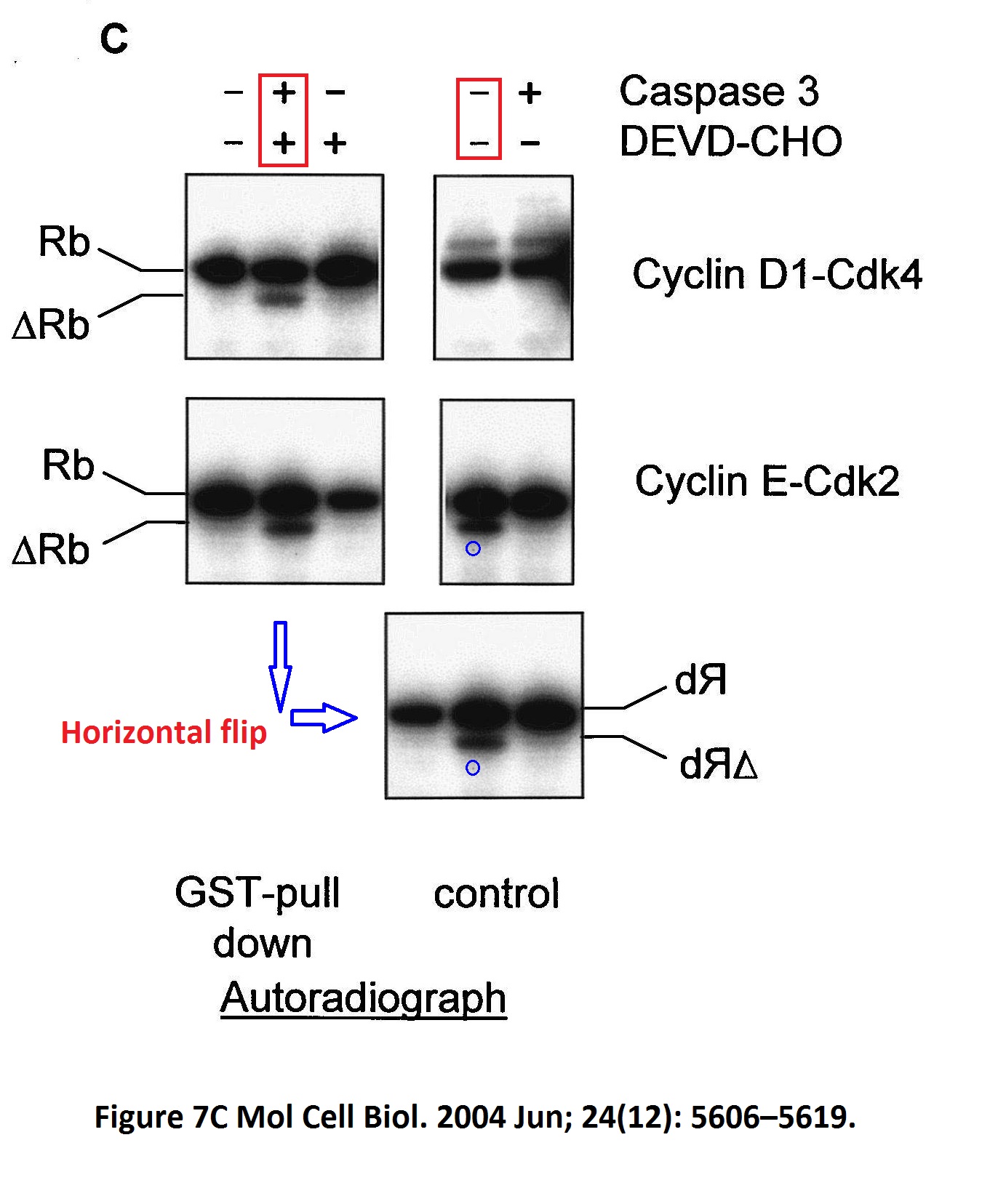


Well, at least we were spared Ball explaining on PubPeer that none of that data fabrication affected any conclusions, as her husband used to. Here a bit more of the Hupp and Ball game, courtesy of Clare Francis:
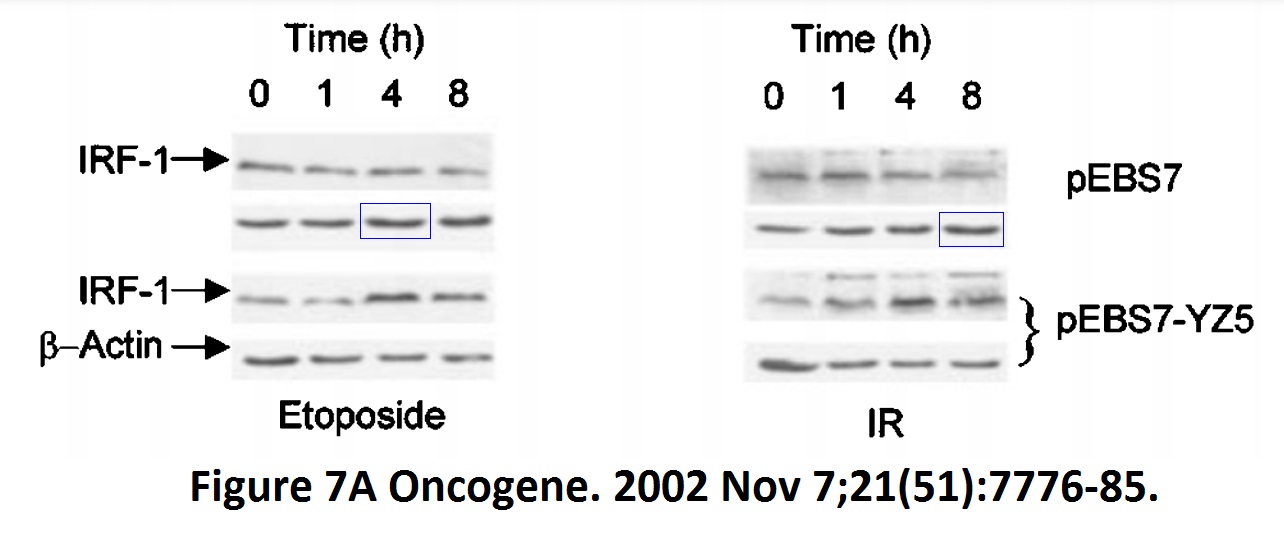



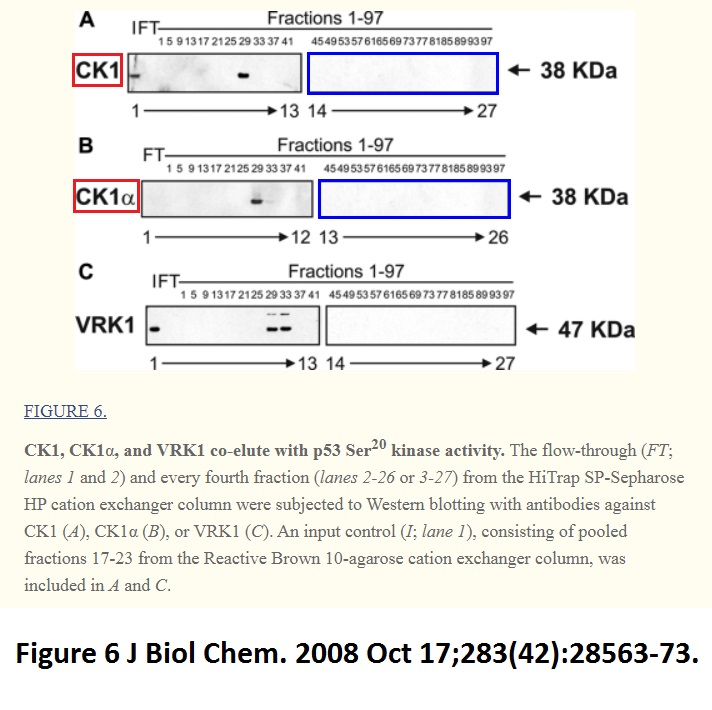
Now, you might say, well this all looks very serious. The University of Edinburgh sure won’t like it, a research misconduct investigation is probably already under way in full steam.
What are you, born yesterday and living the Moon? University of Edinburgh is not investigating anyone, in fact they refuse to admit any notifications of suspected research misconduct so they won’t have to open any investigations. Not on the dean of the veterinary faculty, the bully Argyle, and most certainly not on Hupp and Ball. Although, Edinburgh did investigate someone once, because the external pressure got too high and because the main perpetrator was a Bulgarian woman.
The senior lecturer Irina Stancheva was dismissed. All her partners in data forgery were absolved in full and enjoy their prestigious professorships at prestigious British universities on the virtue of being British males. Even Stancheva’s retractions were coordinated as not to hurt these important gentlemen.
The research integrity guidelines at Edinburgh state:
“Professor Jonathan Seckl, Vice-Principal Planning, Resources and Research Policy, is the main responsible contact for Research Misconduct. Professor Seckl delegates responsibility for research misconduct for each College.”
Seckl never replied to my notifications of course which bureaucratically means I never submitted anything. It is worth mentioning that Seckl is a collaborator of Moshe Szyf (here a questionable paper Weaver et al 2004), and also, the Edinburgh Vice-Principal can sympathise: his brother and Imperial College London professor Michael Seckl has a nice PubPeer record, including a retraction.
That retraction Michael Seckl earned together with Julian Downward, a somewhat controversial professor at The Crick. On the occasion of his other retraction, Downward explained to Retraction Watch that, let me check, yes, “Following a series of exhaustive London Research Institute (LRI) internal and external investigations, it was concluded” that also Dr Downward became a victim of a fraudulent foreigner he nourished at his bosom. A sad and tragic fate befalling many white British men of science.
There are no dirty foreigners to blame in our Hupp and Ball game (except yours truly), so you must understand why Michael Seckl’s brother Jonathan and his Edinburgh colleagues keep disregarding my email notifications. Plus, the Institute of Genetics and Molecular Medicine where Hupp and Ball work is part of College of Medicine and Veterinary Medicine, and its head Moira Whyte has vigorously defended Argyle from bullying complaints, including from a faculty member dying of cancer.
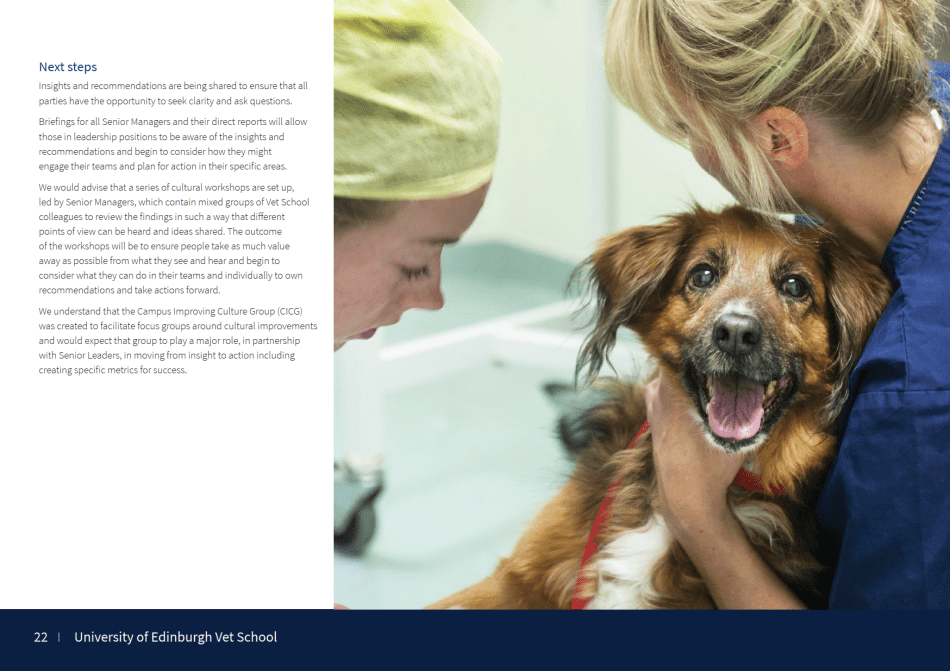
So you see, we up some hardened and ruthless opposition in Edinburgh. Don’t get fooled by the pictures of cuddly animals they deploy. These people will bite your head off if you get too close.
But evil as I am, I found a way in.
Edinburgh may refuse to admit my notification of suspected research misconduct, but I also contacted the University of Dundee, where the Hupp and Ball game originally began in the lab of Sir David Lane. I did this recalling how in 2016 Dundee cracked down on the science fraud by their former lecturer Robert Ryan. Ryan was made to resign, his funding withdrawn, and that despite Ryan’s alma mater University College Cork in Ireland aggressively defending his research, determined to protect at all costs their professor and Ryan’s mentor (and co-author) Maxwell Dow.
So I sent the PubPeer evidence to the University of Dundee, Right away, my notification was acknowledged with this message from Paul Davies, one of university’s research integrity leads:
“Thank you very much for raising this with the School of Life Sciences Research Integrity Group. As an Institution, we are proactively engaged in Research Integrity matters: we deal with the underlying causes of reproducibility issues in research and thoroughly evaluate all concerns and allegations of research misconduct involving our current and former researchers. We subscribe to PubPeer alerts (in fact we worked with PubPeer to enable searching by institution) and react to each one involving the University of Dundee. We are aware of the published comments you highlight and we are currently looking at these and will evaluate them thoroughly.“
Davies then announced to inform “all stakeholders, including the Journals, to establish the facts.” Which will first and foremost include the University of Edinburgh. Maybe Jonathan Seckl will have to grudgingly allow an investigation after all. Expect no misconduct findings though!

Nobody in Edinburgh is answering emails, and neither does Hupp’s and Ball’s mentor Sir David Lane in Stockholm. He should though, even one of his own papers is affected.
Kathryn L. Ball, David P. Lane Human and plant proliferating-cell nuclear antigen have a highly conserved binding site for the p53-inducible gene product p21WAF1 European Journal of Biochemistry (1996) doi: 10.1111/j.1432-1033.1996.0854p.x
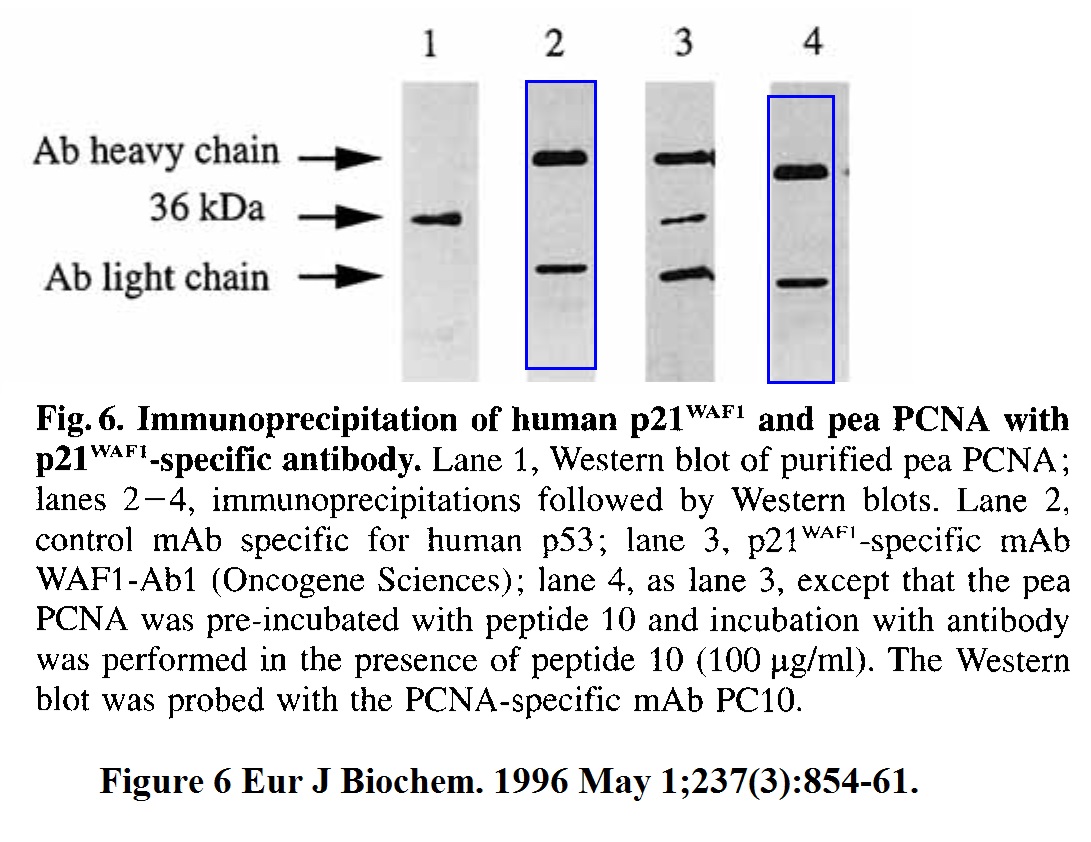


It’s not just Hupp and Ball who like taking a dump in Mol Cell Biol.
Other British groups like to take a dump there there too, and Mol Cell Biol, which for a long time had a British Editor-in-Chief, Roger Davis, is happy with that.
The cat shat on the mat.
Oxford, England.
https://pubpeer.com/publications/80B993ECD687945AA6EB3F996AA084#2
https://pubpeer.com/publications/80B993ECD687945AA6EB3F996AA084#3
https://pubpeer.com/publications/80B993ECD687945AA6EB3F996AA084#4
https://pubpeer.com/publications/80B993ECD687945AA6EB3F996AA084#5
https://pubpeer.com/publications/80B993ECD687945AA6EB3F996AA084#6
https://pubpeer.com/publications/80B993ECD687945AA6EB3F996AA084#7
Brits abroad. Presently: https://www.crick.ac.uk/research/find-a-researcher/karen-vousden
https://pubpeer.com/publications/B518680DD43B568C9DA7F41F9BBE54#1
https://pubpeer.com/publications/B518680DD43B568C9DA7F41F9BBE54#3
https://pubpeer.com/publications/B518680DD43B568C9DA7F41F9BBE54#4
https://pubpeer.com/publications/B518680DD43B568C9DA7F41F9BBE54#5
LikeLike
https://era.ed.ac.uk/handle/1842/29310
Coomassie panels figures 4.9 and 5.7 much more similar than expected.
//s.imgur.com/min/embed.js
LikeLike
Cell Cycle . 2011 Mar 15;10(6):932-50. doi: 10.4161/cc.10.6.15012. Epub 2011 Mar 15.
p21(WAF1) is component of a positive feedback loop that maintains the p53 transcriptional program
Lisa Y Pang 1, Mary Scott, Richard L Hayward, Hisham Mohammed, C Bruce A Whitelaw, Graeme C M Smith, Ted R Hupp
Affiliation
1CRUK Cell Signalling Unit, Institute of Genetics and Molecular Medicine, Edinburgh, Scotland, UK.
PMID: 21368573
Figure 1. Very similar except the concentrations of cyclohexamide (CHX) are different.
Source PhD: https://era.ed.ac.uk/handle/1842/29310
LikeLike
Correction: Cell Cycle . 2011 Mar 15;10(6):932-50.
Concentration of cycloheximide is the same for both paper and PhD thesis. 30 mircogram/ml.
Observation was not valid.
LikeLike
“Ted Hupp and Kathryn Ball may very well feel like kissing David Argyle on both cheeks.”
To paraphrase the great Peter Cook “upper or lower”?
LikeLiked by 1 person
“Neil Perkins, now that name rings a bell. Alarm bells, actually.”
EMBO J. 2005 Mar 23;24(6):1157-69. doi: 10.1038/sj.emboj.7600608. Epub 2005 Mar 10.
Regulation of NF-kappaB and p53 through activation of ATR and Chk1 by the ARF tumour suppressor
Sonia Rocha 1, Michelle D Garrett, Kirsteen J Campbell, Katie Schumm, Neil D Perkins
Affiliation
1School of Life Sciences, Division of Gene Regulation and Expression, University of Dundee, Dundee, Scotland, UK.
PMID: 15775976 PMCID: PMC556410 DOI: 10.1038/sj.emboj.7600608
Figure 7. Seems different exposures of same bands.
https://pubpeer.com/publications/F617FF82C8A50AC7BD56555D96BCDA#1
LikeLike
Nucleic Acids Res . 2003 Nov 1;31(21):6104-16. doi: 10.1093/nar/gkg817.
Identification of peptide inhibitors of pre-mRNA splicing derived from the essential interaction domains of CDC5L and PLRG1
Paul Ajuh 1, Angus I Lamond
Affiliation
1The University of Dundee, School of Life Sciences, Wellcome Trust Biocentre, Dow Street, Dundee DD1 5EH, UK.
PMID: 14576297 PMCID: PMC275459 DOI: 10.1093/nar/gkg817
Figure 6. Much more similar than expected.
https://pubpeer.com/publications/214C986BB6462E713F07CDC2034048
LikeLike
J Biol Chem. 2005 Mar 18;280(11):10264-76. doi: 10.1074/jbc.M408748200. Epub 2005 Jan 4.
SIRT1 deacetylation and repression of p300 involves lysine residues 1020/1024 within the cell cycle regulatory domain 1
https://www.jbc.org/action/showPdf?pii=S0021-9258%2819%2930425-9
Toula Bouras‡§, Maofu Fu‡§, Anthony A. Sauve¶, Fang Wang**, Andrew A. Quong‡,
Neil D. Perkins‡‡, Ronald T. Hay§§, Wei Gu¶¶, and Richard G. Pestell‡
From the ‡Department of Oncology, Lombardi Comprehensive Cancer Center, Georgetown University, Washington, D. C.
20057, the ¶Department of Biochemistry and the **Laboratory of Macromolecular Analysis and Proteomics,
Albert Einstein College of Medicine, Bronx, New York 10461, the ‡‡School of Life Sciences,
Division of Gene Regulation and Expression, University of Dundee, Dundee DD15EH, Scotland, United Kingdom, the §§Center for Biomolecular Sciences, University of St. Andrews, St. Andrews, Fife KY16 9TS, United Kingdom,
and the ¶¶Institute of Transgenics and Department of Pathology, College of Physicians and Surgeons, Columbia University, New York, New York 10032
Many similar elements in figure 2A.
https://pubpeer.com/publications/773FC61FF7E2D3AF9B2542731D7BA6#5
LikeLike
J Immunol. 2008 Feb 15;180(4):2429-42. doi: 10.4049/jimmunol.180.4.2429.
A238L inhibits NF-ATc2, NF-kappa B, and c-Jun activation through a novel mechanism involving protein kinase C-theta-mediated up-regulation of the amino-terminal transactivation domain of p300
https://www.jimmunol.org/content/180/4/2429/tab-article-info
AUTHOR INFORMATION
Aitor G. Granja*, Neil D. Perkins† and Yolanda Revilla2,*
*Centro de Biología Molecular “Severo Ochoa,” Consejo Superior de Investigaciones Científicas-Universidad Autónoma de Madrid, Madrid, Spain; and
†School of Life Sciences, Division of Gene Regulation and Expression, University of Dundee, Dundee, Scotland, United Kingdom
Problematic data most figures.https://pubpeer.com/publications/D5D1F1DCC207C82E0888E921627AA5
https://pubpeer.com/publications/D5D1F1DCC207C82E0888E921627AA5#13
A 2015 correction for figures 2B and 8E has been published for this paper.
http://www.jimmunol.org/content/194/4/2032.short
“In Fig. 2B (third panel from the top) the authors inadvertently included the same Western blot panel that is presented in Fig. 2E (third panel from the top). The correct panel for Fig. 2B, representing an immunoprecipitation with anti-p65 followed by a Western blot with anti-p300 Abs, is shown in the figure below.
In Fig. 8E (second panel from the top), the authors inadvertently scanned and included a horizontally flipped image of the same Western blot that is presented in Fig. 8C (second panel from the top). The correct panel for Fig. 8E, representing an immunoprecipitation with anti–PKC-θ followed by a Western blot with anti–PKC-θ Abs as a PKC immunoprecipitation control, is shown in the figure below.”
What about figures 4,5,6 and 9?
LikeLike
Biochem J. 2010 Mar 15; 426(Pt 3): 345–354.
Published online 2010 Feb 24. Prepublished online 2009 Dec 15. doi: 10.1042/BJ20091630
PMCID: PMC2829238
PMID: 20001970
Thr435 phosphorylation regulates RelA (p65) NF-κB subunit transactivation
John M. O’Shea and Neil D. Perkins1
Author information Article notes Copyright and License information Disclaimer
Department of Cellular and Molecular Medicine, School of Medical Sciences, University of Bristol, University Walk, Bristol BS8 1TD, U.K.
1To whom correspondence should be addressed (email n.d.perkins@bristol.ac.uk)
Figure 1A. Much more similar than expected.
LikeLike
R Soc Open Sci. 2016 Sep 21;3(9):160384. doi: 10.1098/rsos.160384. eCollection 2016 Sep.
The natural selection of bad science
Paul E Smaldino 1, Richard McElreath 2
Affiliations
1Cognitive and Information Sciences , University of California , Merced, CA 95343, USA.
2Department of Human Behavior , Ecology, and Culture, Max Planck Institute for Evolutionary Anthropology , Leipzig, Germany.
PMID: 27703703 PMCID: PMC5043322 DOI: 10.1098/rsos.160384
https://royalsocietypublishing.org/doi/pdf/10.1098/rsos.160384
Taken at its highest “The persistence of poor methods results partly from incentives that favour them, leading to the natural selection of bad science. This dynamic requires no conscious strategizing-no deliberate cheating nor loafing-by scientists, only that publication is a principal factor for career advancement” explains the likes of Neil Perkins, Ted Hupp and Kathryn Ball.
LikeLike
EMBO J. 2007 Apr 18;26(8):2115-26. doi: 10.1038/sj.emboj.7601657. Epub 2007 Mar 22.
A new p38 MAP kinase-regulated transcriptional coactivator that stimulates p53-dependent apoptosis
https://www.embopress.org/doi/full/10.1038/sj.emboj.7601657#
Ana Cuadrado 1, Vanesa Lafarga 1, Peter CF Cheung 2, Ignacio Dolado1, Susana Llanos1,
Philip Cohen 2 and Angel R Nebreda 1
1CNIO (Spanish National Cancer Center), Madrid, Spain
2MRC Protein Phosphorylation Unit, University of Dundee, Dundee, UK
*Corresponding authors: Molecular Oncology Programme, CNIO (Spanish National Cancer Center), Melchor Fernández Almagro 3, Madrid -28029 Spain. Tel.: +34 91 2246900; Fax: +34 91 7328033; E-mail: anebreda@cnio.es or E-mail: acuadrado@cnio.es
Much more similar and different than expected.
https://pubpeer.com/publications/0F6F8651B20FBBD42C8E4C02AC31F6#1
Much more similar than expected.
https://pubpeer.com/publications/0F6F8651B20FBBD42C8E4C02AC31F6#2
LikeLike
24 Dec 2021 Editorial Expression of Concern for:
Nucleic Acids Res . 2004 Oct 14;32(18):5553-69. doi: 10.1093/nar/gkh876. Print 2004.
Protein kinase CK2 phosphorylation regulates the interaction of Kaposi’s sarcoma-associated herpesvirus regulatory protein ORF57 with its multifunctional partner hnRNP K
Poonam Malik 1, J Barklie Clements
Affiliation
1
Division of Virology, Institute of Biomedical and Life Sciences, University of Glasgow, Church Street, Glasgow, G11 5JR, Scotland, UK.
PMID: 15486205 PMCID: PMC524287 DOI: 10.1093/nar/gkh876
Pubpeer comments: https://pubpeer.com/publications/BCE5F8FADDAE33607C9EC30F00AE3D
24 Dec 2021 Editorial Expression of Concern
https://academic.oup.com/nar/advance-article/doi/10.1093/nar/gkab1294/6482580
Nucleic Acids Research, gkab1294, https://doi.org/10.1093/nar/gkab1294
Published: 24 December 2021
In October 2004, NAR published the article ‘Protein kinase CK2 phosphorylation regulates the interaction of Kaposi’s sarcoma-associated herpesvirus regulatory protein ORF57 with its multifunctional partner hnRNP K’ by Poonam Malik and J. Barklie Clements (1).
The Editors were alerted in 2021 that the blots depicted in several figures show unusual levels of similarity. As the Authors have not been able to provide the original data, the matter has been referred to the Author’s institution for further investigation. In the interim, while the results themselves may not be in question, the Editors advise Readers to examine the details of this study with particular care.
Julian E. Sale, Barry L. Stoddard
Senior Executive Editors
REFERENCES
1. Malik P., Clements J.B. Protein kinase CK2 phosphorylation regulates the interaction of kaposi’s sarcoma-associated herpesvirus regulatory protein ORF57 with its multifunctional partner hnRNP K. Nucleic Acids Res. 2004; 32:5553–5569.
LikeLike
https://www.business-school.ed.ac.uk/writingthefuture/stories/connection-and-community
Poonam Malik
MBA 2016
Alumni 100
Director, Board Member & Angel Investor, Scottish Enterprise and Investing Women Angels
With a PhD from the University of Glasgow and an MBA from the Business School [University of Edinburgh Business School], Poonam now sits on a number of boards and committees for organisations such as the Royal Society of Edinburgh and Scottish Enterprise.
LikeLike
Curr Biol. 1996 Jan 1;6(1):84-91. doi: 10.1016/s0960-9822(02)00425-6.
Inhibition of pRb phosphorylation and cell-cycle progression by a 20-residue peptide derived from p16CDKN2/INK4A
R Fåhraeus 1, J M Paramio, K L Ball, S Laín, D P Lane
Affiliation
1Cell Transformation Group, University of Dundee, UK. RFAHRAES/bad.dundee.ac.uk
PMID: 8805225 DOI: 10.1016/s0960-9822(02)00425-6
Figure 4(g). vertical straight changes in signal between last 4 lanes. It is supposed to be a time course.
LikeLike
“Mary T Scott , Angela Ingram , Kathryn L Ball PDK1-dependent activation of atypical PKC leads to degradation of the p21 tumour modifier protein The EMBO Journal (2002) doi: 10.1093/emboj/cdf684”
More problematic data EMBO J. 2002 Dec 16; 21(24): 6771–6780.
Problematic data figure 6D. Much more similar than expected.
LikeLike
EMBO J. 2002 Dec 16;21(24):6771-80.
Figures 1F and 1G much more similar than expected.
LikeLike
https://www.ed.ac.uk/profile/margaret-frame
Professor of Cancer Research. Director: Institute of Genetics and Cancer
Cancer Research UK Edinburgh Centre
From 2002-2007, Margaret was Deputy Director of the CRUK Beatson Institute in Glasgow, after which she moved to the University of Edinburgh (UoE).
https://www.research.ed.ac.uk/en/persons/margaret-frame/publications
2004
Calpain activity is generally elevated during transformation but has oncogene-specific biological functions
Carragher, N. O., Fonseca, B. D. & Frame, M. C., 2004, In: Neoplasia. 6, 1, p. 53-73 21 p.
Research output: Contribution to journal › Article › peer-review
Neoplasia Volume 6, Issue 1, January–February 2004, Pages 53-73
Calpain Activity Is Generally Elevated during Transformation but Has Oncogene-Specific Biological Functions1
lN.O.CarragherB.D.FonsecaM.C.Frame*†
*
The Beatson Institute for Cancer Research, Cancer Research UK Beatson Laboratories, Glasgow G61 1BD, Scotland, UK
†
Institute of Biological and Life Sciences, University of Glasgow, Glasgow G12 800, Scotland, UK
Received 21 August 2003, Revised 20 October 2003, Accepted 22 October 2003, Available online 3 April 2014.
Figure 3. Much more similar than expected.
LikeLike
Curr Biol. 2010 Jun 22;20(12):1086-92. doi: 10.1016/j.cub.2010.04.042. Epub 2010 May 20.
A complex between FAK, RACK1, and PDE4D5 controls spreading initiation and cancer cell polarity
Bryan Serrels 1, Emma Sandilands, Alan Serrels, George Baillie, Miles D Houslay, Valerie G Brunton, Marta Canel, Laura M Machesky, Kurt I Anderson, Margaret C Frame
Affiliation
1Edinburgh Cancer Research UK Centre, Institute of Genetics and Molecular Medicine, University of Edinburgh, Western General Hospital, Crewe Road South, Edinburgh EH4 2XR, UK.
PMID: 20493699 DOI: 10.1016/j.cub.2010.04.042
Figure 1E. Much more similar than expected.
Figure 1D. Left set of panels. Lower panel. Vertical, straight change in signal between rightmost two lanes. Rightmost lane looks like it is on its own rectangle of background. Upper panel. Not obvious that there is a vertical, straight change in signal between rightmost two lanes.
Figure 1D. Right set of panels. FAK and FAK Y397 panels look misaligned.
LikeLike
Curr Biol . 2003 Aug 19;13(16):1442-50. doi: 10.1016/s0960-9822(03)00544-x.
A novel role for FAK as a protease-targeting adaptor protein: regulation by p42 ERK and Src
Neil O. Carragher,1,* M. Andrew Westhoff,1 Valerie J. Fincham,1 Michael D. Schaller,3 and Margaret C. Frame1,2,*
1 The Beatson Institute for Cancer Beatson Laboratories Glasgow G61 1BD, Scotland, United Kingdom.
2 United Kingdom Institute of Biological and Life Sciences , University of Glasgow, Glasgow G12 8QQ, Scotland, United Kingdom.
3 Department of Cell and Developmental Biology, Lineberger Comprehensive Cancer Center, Center for Thrombosis and Hemostasis,
University of North Carolina, Chapel Hill, North Carolina 27599.
PMID: 12932330 DOI: 10.1016/s0960-9822(03)00544-x
Problematic data figure 1B. Vertical, straight changes in signal in Lysates c-myc FAK panel,
but not in Lysates phosho-p42ERK panel.
LikeLike
Oncogene . 1998 Apr 16;16(15):2017-28. doi: 10.1038/sj.onc.1201727.
Expression of the v-Src oncoprotein in fibroblasts disrupts normal regulation of the CDK inhibitor p27 and inhibits quiescence
D Johnson 1, M C Frame, J A Wyke
Affiliation
1
Beatson Institute for Cancer Research, CRC Beatson Laboratories, Glasgow, UK.
PMID: 9591786 DOI: 10.1038/sj.onc.1201727
Problematic data figures 3a and 4a.
Problematic data figure 3a. Vertical, straight change in background upper panel, but not in lower panel.
Problematic data figure 4a. Much more similar than expected. Vertical, straight changes between lanes in some panels, but not others.
https://www.ed.ac.uk/profile/margaret-frame
Publications
1998
Expression of the v-Src oncoprotein in fibroblasts disrupts normal regulation of the CDK inhibitor p27 and inhibits quiescence
Johnson, D., Frame, M. C. & Wyke, J. A., 16 Apr 1998, In: Oncogene. 16, 15, p. 2017-28 12 p.
Research output: Contribution to journal › Article › peer-review
LikeLike
Prof Margaret C Frame is another person who may very well feel like kissing David Argyle on both cheeks, if she hasn’t done so already.
It is quite possible that Prof Margaret Frame has already called Ted Hupp and Kathryn Ball into her office only to find out that she herself has dodgy data! They may need kissing on both cheeks as well.
It is shame that pantomime season is just over.
https://www.ed.ac.uk/profile/margaret-frame
Director: Institute of Genetics and Cancer
https://www.ed.ac.uk/cancer-centre/research/hupp-group
Institute of Genetics and Cancer
https://www.ed.ac.uk/cancer-centre/research/ball-group
Institute of Genetics and Cancer
LikeLike
If Dr Frame ever called Hupp & Ball into her office, it was to discuss what to do with this horrid Schneider. Maybe I should write a follow up story ” Who Framed Maggie Frame?”
LikeLike
Proc Natl Acad Sci U S A. 2010 Jan 5; 107(1): 246–251.
Published online 2009 Dec 14. doi: 10.1073/pnas.0908428107
PMCID: PMC2806749
PMID: 20018721
Mutant p53 drives metastasis and overcomes growth arrest/senescence in pancreatic cancer
Jennifer P. Morton,a,b Paul Timpson,a Saadia A. Karim,a Rachel A. Ridgway,a Dimitris Athineos,a,b Brendan Doyle,a Nigel B. Jamieson,b Karin A. Oien,b Andrew M. Lowy,c Valerie G. Brunton,d Margaret C. Frame,d T. R. Jeffry Evans,a,b and Owen J. Sansom a,1
Author information
aBeatson Institute for Cancer Research, Glasgow G61 1BD, United Kingdom;
bCentre for Oncology and Applied Pharmacology, Division of Cancer Sciences and Molecular Pathology, University of Glasgow, Glasgow G61 1BD, United Kingdom;
cDivision of Surgical Oncology, Moores UCSD Cancer Center, La Jolla, CA 92093; and
dEdinburgh Cancer Research Centre, Institute of Genetics and Molecular Medicine, University of Edinburgh, Edinburgh EH4 2XR, United Kingdom
1To whom correspondence should be addressed. E-mail: o.sansom@beatson.gla.ac.uk
https://pubpeer.com/publications/25346BA9CE6EED23D3675BD666FB4B
Figure 2. Much more similar than expected.
LikeLike
More prorblematic data Neoplasia Volume 6, Issue 1, January–February 2004, Pages 53-73.
Problematic data figure 7B. Much more similar than expected.
LikeLike
Cancer Res. 2005 Feb 15;65(4):1335-42. doi: 10.1158/0008-5472.CAN-04-1949.
Identification of Src-specific phosphorylation site on focal adhesion kinase: dissection of the role of Src SH2 and catalytic functions and their consequences for tumor cell behavior
Valerie G Brunton 1 , Egle Avizienyte, Valerie J Fincham, Bryan Serrels, Chester A Metcalf 3rd, Tomi K Sawyer, Margaret C Frame
Affiliation
Problematic data figure 6. Much more similar than expected.
LikeLike
PLoS Pathog. 2009 Jan; 5(1): e1000271.
Published online 2009 Jan 23. doi: 10.1371/journal.ppat.1000271
PMCID: PMC2621354
PMID: 19165331
The IpaC Carboxyterminal Effector Domain Mediates Src-Dependent Actin Polymerization during Shigella Invasion of Epithelial Cells
Joëlle Mounier, 1 , 2 Michel R. Popoff, 3 Jost Enninga, 1 , 2 Margaret C. Frame, 4 Philippe J. Sansonetti, 1 , 2 and Guy Tran Van Nhieu 1 , 2 , *
B. Brett Finlay, Editor
Author information
1 Unité de Pathogénie Microbienne Moléculaire, Institut Pasteur, Paris, France,
2 Inserm U786, Institut Pasteur, Paris, France,
3 Unité de Recherche et d’Expertise Bactéries anaérobies et Toxines, Institut Pasteur, Paris, France,
4 Institute of Genetics and Molecular Medicine, University of Edinburgh, Edinburgh Cancer Research Centre, Western General Hospital, Edinburgh, United Kingdom,
University of British Columbia, Canada
* E-mail: rf.ruetsap@navnartg
Conceived and designed the experiments: GTVN. Performed the experiments: JM GTVN. Analyzed the data: JM MRP PJS GTVN. Contributed reagents/materials/analysis tools: MRP JE MCF GTVN. Wrote the paper: GTVN.
This work was funded in part by a grant from the Agence Nationale de la Recherche, Programme de Microbiologie-Immunologie (project APV05093JSA) to GTVN and by RO1 AI067949 grant from the National Institutes of Health to Tina Izard (Scripps Florida) and GTVN.
Problematic data figure 8B. Much more similar than expected. Could be a simple mistake.
LikeLike
Continuation Curr Biol . 2003 Aug 19;13(16):1442-50.
Figure 2B. Splices in phospho-p42ERK and FAK panels not accompanied by splices in the other panel.
https://pubpeer.com/publications/5A4DEFC9EA5908C3C096E429964646#2
Like Prof Margaret Frame, Prof Neil Carragher has moved from Glasgow to the University of Edinburgh.
https://euanmacdonaldcentre.org/people/prof-neil-carragher
Professor of Drug Discovery
Cancer Research UK – Edinburgh Centre, Institute of Genetics & Cancer, University of Edinburgh
LikeLike
Nat Cell Biol . 2007 Sep;9(9):1046-56. doi: 10.1038/ncb1626. Epub 2007 Aug 26.
Focal adhesion kinase controls actin assembly via a FERM-mediated interaction with the Arp2/3 complex
Bryan Serrels 1, Alan Serrels, Valerie G Brunton, Mark Holt, Gordon W McLean, Christopher H Gray, Gareth E Jones, Margaret C Frame
Affiliation
1
The Beatson Institute for Cancer Research, Cancer Research UK Beatson Laboratories, Garscube Estate, Switchback Road, Bearsden, Glasgow G61 1BD, UK.
PMID: 17721515 DOI: 10.1038/ncb1626
Problematic data figure 2. Much more similar and different than expected.
See: https://imgur.com/T5kMgc0
LikeLike
“his brother [Jonathan Seckl} and Imperial College London professor Michael Seckl has a nice PubPeer record, including a retraction.
Cellular Signalling Volume 19, Issue 5, May 2007, Pages 1081-1092
Critical role for lipid raft-associated Src kinases in activation of PI3K-Akt signalling
Alexandre Arcaro a b Muriel Aubert a Maria E.Espinosa d e l Hierroa Umm e K.Khanzada a Smaragda Angelidou a Teresa D.Tetley c Anne G.Bittermann d
Margaret C.Frame e Michael J.Seckl a
a Lung Cancer Biology Group, Division of Medicine, Imperial College Faculty of Medicine, Hammersmith Hospital Campus, Du Cane Road, London W12 ONN, United Kingdom
b Division of Clinical Chemistry and Biochemistry, Department of Pediatrics, University of Zurich, Steinwiesstrasse 75, 8032 Zurich, Switzerland
c Lung Cell Biology, National Heart and Lung Institute, Imperial College Faculty of Medicine, Dovehouse Street, London SW3 6LY, United Kingdom
d Elektronenmikroskopisches Zentrallabor, University of Zurich, Gloriastrasse 30/32, 8006 Zurich, SwitzerlandeThe Beatson Institute for Cancer Research, Cancer Research UK Beatson Laboratories, Glasgow G61 1BD, United Kingdom
Received 1 December 2006, Revised 12 December 2006, Accepted 12 December 2006, Available online 29 December 2006.PMID: 17275257 DOI: 10.1016/j.cellsig.2006.12.003
Problematic data figure 7C.
SYF Western blot PKB panel. Vertical, straight changes in signal between lanes 2 and 3, and between lanes 4 and 5 and between lanes 7 and 8.
No vertical, straight changes in signal in SYF Western blot p-PKB (S473).
LikeLike
Br J Cancer. 2004 Jul 19;91(2):381-8. doi: 10.1038/sj.bjc.6601913.
Evidence for colorectal cancer cell specificity of aspirin effects on NF kappa B signalling and apoptosis
F V N Din 1, M G Dunlop, L A Stark
Affiliation
1Colon Cancer Genetics Group, University of Edinburgh Department of Oncology and MRC Human Genetics Unit, Western General Hospital, Crewe Rd, Edinburgh EH4 2XU, Scotland.
PMID: 15188000 PMCID: PMC2409803 DOI: 10.1038/sj.bjc.6601913
Figure 3. Much more similar than expected.
https://pubpeer.com/publications/DC1352F731E0A68B25CC858362DBD5
LikeLike
Nucleic Acids Res . 2007;35(16):5312-22. doi: 10.1093/nar/gkm493. Epub 2007 Aug 8.
Phospho-epitope binding by the BRCT domains of hPTIP controls multiple aspects of the cellular response to DNA damage
Ivan M Munoz 1, Paul A Jowsey, Rachel Toth, John Rouse
Affiliation
1
MRC Protein Phosphorylation Unit, Sir James Black Centre, University of Dundee, Dundee DD1 5EH, Scotland, UK.
PMID: 17690115 PMCID: PMC2018624 DOI: 10.1093/nar/gkm493
Fresh problematic data, this time figure 1C.
Much more similar than expected.
2017 correction.
https://academic.oup.com/nar/article/45/22/13094/4607807
Pubpeer comments: https://pubpeer.com/publications/80C3FDDC9E09B3BF7CC12B9193C85C
LikeLike
DNA Repair (Amst). 2007 Oct 1;6(10):1536-44. doi: 10.1016/j.dnarep.2007.04.011. Epub 2007 Jun 5.
Characterisation of the sites of DNA damage-induced 53BP1 phosphorylation catalysed by ATM and ATR
Paul Jowsey 1, Nicholas A Morrice, C James Hastie, Hilary McLauchlan, Rachel Toth, John Rouse
Affiliations expand
PMID: 17553757 DOI: 10.1016/j.dnarep.2007.04.011
Erratum inhttps://www.sciencedirect.com/science/article/pii/S1568786417303828
Corrigendum to “Characterisation of the sites of DNA damage-induced 53BP1 phosphorylation catalysed by ATM and ATR” [DNA Repair 6 (2007) 1536-1544].
Jowsey P, Morrice NA, Hastie CJ, MacLauchlan H, Toth R, Rouse J.
DNA Repair (Amst). 2018 May;65:80. doi: 10.1016/j.dnarep.2017.10.012. Epub 2018 Feb 12.
PMID: 29449168
“Control lanes from Fig. 3B were inadvertently duplicated in Fig. 3A. The authors regret this mistake. For the purposes of maintaining the integrity of the research record, a repeat of the experiment in Fig. 3A is presented. To align timepoints for ease of comparison, the top four panels were grouped and scaled independently of the grouped bottom three panels. This correction does not alter the conclusions of the article.”
Pubpeer comments: https://pubpeer.com/publications/FB3ED434D2377D52A11EF4731E24A1
Problematic data: https://pubpeer.com/publications/FB3ED434D2377D52A11EF4731E24A1#1
https://rse.org.uk/fellowship/john-rouse/
ELECTED: 2017
DISCIPLINE: Cell and Molecular Biology
Professor John William Rouse FRSE
Professor in Chromosome Biology, University of Dundee.
Professor John Rouse gained his PhD from the University of Dundee in 1996 before moving to the University of Cambridge to hold a postdoctoral position. He returned to Dundee in 2002 and has been Professor of Chromosome Biology since 2011. John’s research focuses on DNA repair and his laboratory has discovered a range of factors vital for DNA repair that also prevent human diseases such as cancer.
LikeLike
Mol Cell Biol. 2007 Sep; 27(18): 6433–6445.Published online 2007 Jul 16. doi: 10.1128/MCB.00135-07PMCID: PMC2099619PMID: 17636031
Phosphorylation of Slx4 by Mec1 and Tel1 Regulates the Single-Strand Annealing Mode of DNA Repair in Budding Yeast▿
Sonja Flott,1,† Constance Alabert,2 Geraldine W. Toh,1 Rachel Toth,1 Neal Sugawara,3 David G. Campbell,1 James E. Haber,3 Philippe Pasero,2 and John Rouse1,*
Author information MRC Protein Phosphorylation Unit, James Black Centre, University of Dundee, Dundee DD1 5EH, United Kingdom,1
Institute of Human Genetics, CNRS UPR 1142, 141 Rue de la Cardonille, 34396 Montpellier, France,
2
Rosenstiel Basic Medical Sciences Research Centre, Waltham, Massachusetts
3
*Corresponding author. Mailing address: MRC Protein Phosphorylation Unit, James Black Centre, University of Dundee, Dundee DD1 5EH, United Kingdom.
Phone: 44-1382-385490. Fax: 44-1382-223778. E-mail: j.rouse@dundee.ac.uk
†Present address: Gurdon/CRUK Institute, University of Cambridge, Tennis Court Rd., Cambridge, United Kingdom.
Problematic data figure 3A. Much more similar than expected.
Please pay attention to all the specks and scratches inside the yellow rectangles.
LikeLike
RE: Cellular Signalling Volume 19, Issue 5, May 2007, Pages 1081-1092
Critical role for lipid raft-associated Src kinases in activation of PI3K-Akt signalling
Alexandre Arcaro a b Muriel Aubert a Maria E.Espinosa d e l Hierroa Umm e K.Khanzada a Smaragda Angelidou a Teresa D.Tetley c Anne G.Bittermann d
Margaret C.Frame e Michael J.Seckl a
https://www.sciencedirect.com/journal/cellular-signalling/about/editorial-board
Editor-in-Chief
George Baillie
University of Glasgow, Glasgow, United Kingdom
George Baillie Pubpeer record: https://pubpeer.com/search?q=george+baillie
https://retractionwatch.com/2021/11/23/university-of-glasgow-in-discussions-to-retract-seven-papers-confirming-retraction-watch-reporting/
George Ballie is author on all seven papers to be retracted.
LikeLike
I love this one for its homegrown simplicity.
J Biol Chem. 1996 Nov 15;271(46):29453-60. doi: 10.1074/jbc.271.46.29453.
[D-Arg1,D-Trp5,7,9,Leu11]Substance P coordinately and reversibly inhibits bombesin- and vasopressin-induced signal transduction pathways in Swiss 3T3 cells
M J Seckl 1, T Higgins, E Rozengurt
Affiliation
1Imperial Cancer Research Fund, London WC2A 3PX, United Kingdom.
PMID: 8910612 DOI: 10.1074/jbc.271.46.29453
https://pubpeer.com/publications/C4A38F058601D3B951042F2B964D98
LikeLike
“Imperial College London professor Michael Seckl has a nice PubPeer record, including a retraction.”
Why doesn’t prof Michael Seckl correct his data?
There’s more to it than the 2002 JBC paper retracted by the journal in 2015.
https://pubpeer.com/publications/A1705738746C3214F7BD831BFD46AA#4
https://retractionwatch.com/2015/06/30/jbc-cancer-paper-felled-by-duplication-is-one-authors-second-retraction-this-month/
https://pubpeer.com/publications/ED0203B87AD7EB7271A698CE19F6F8#3
https://pubpeer.com/publications/4317FE23B3FF64C64DC277FCAD3D4F#2
https://pubpeer.com/publications/98509A84E96189EC0F0D99D9F95223#5
LikeLike
Mol Cell Biol. 2004 Oct; 24(20): 9006–9018.doi: 10.1128/MCB.24.20.9006-9018.2004
PMCID: PMC517871 PMID: 15456874
c-Jun-Deficient Cells Undergo Premature Senescence as a Result of Spontaneous DNA Damage Accumulation
Ann MacLaren,1,* Elizabeth J. Black,1 William Clark,1 and David A. F. Gillespie1,2
Author information Beatson Institute for Cancer Research, Bearsden,1 Institute of Biomedical and Life Sciences, University of Glasgow, Glasgow, United Kingdom2
*Corresponding author. Present address: The Scripps Research Institute, Department of Molecular Biology, 10550 North Torrey Pines Rd., La Jolla, CA 92037. Phone: (858) 784-2825. Fax: (858) 784-2265. E-mail: annmac@scripps.edu
Problematic data figure 3. Much more similar than expected.
LikeLike
Mol Cell Biol. 2004 Feb;24(4):1540-59. doi: 10.1128/MCB.24.4.1540-1559.2004.
Invasion of normal human fibroblasts induced by v-Fos is independent of proliferation, immortalization, and the tumor suppressors p16INK4a and p53
Linda A Scott 1, J Keith Vass, E Kenneth Parkinson, David A F Gillespie, Joseph N Winnie, Bradford W Ozanne
Affiliation
1Beatson Institute for Cancer Research, Cancer Research UK Beatson Laboratories, Glasgow G61 1BD, United Kingdom.
PMID: 14749371 PMCID: PMC344183 DOI: 10.1128/MCB.24.4.1540-1559.2004
Figure 4A. Much more similar than expected.
https://pubpeer.com/publications/EE62E88CF2567DC29A0F5D6AB845E0
LikeLike
Science . 2002 Oct 25;298(5594):834-6. doi: 10.1126/science.1074683.
Targeting of cyclic AMP degradation to beta 2-adrenergic receptors by beta-arrestins
Stephen J. Perry,1 *George S. Baillie,2 *Trudy A. Kohout,1 * Ian McPhee,2 † Maria M. Magiera,2 Kok Long Ang,3 William E. Miller,1 Alison J. McLean,2 Marco Conti,3 Miles D. Houslay,2 Robert J. Lefkowitz1 ‡
Affiliations
1 Howard Hughes Medical Institute, Departments of Medicine and Biochemistry, Duke University Medical Center, Durham, NC 27710, USA.
2 Molecular Pharmacology Group, Division of Biochemistry and Molecular Biology, Institute of Biomedical and Life Sciences, University of Glasgow, Scotland, G12 8QQ, UK.
3 Division of Reproductive Biology, Department of Gynecology and Obstetrics, Stanford University, School of Medicine, Stanford, CA 94305, USA.
*These authors contributed equally to this work. †Present address: Scottish Biomedical, Todd Campus West of Scotland Science Park, Glasgow, Scotland, UK. ‡To whom correspondence should be addressed.
PMID: 12399592 DOI: 10.1126/science.1074683
Problematic data figure 4A. Vertical, straight change in signal in IB: PDE4D panel, but no obvious splice in beta-arrestin panel.
LikeLike
Oncotarget. 2014 Aug; 5(15): 6142–6167.
Published online 2014 Jul 8. doi: 10.18632/oncotarget.2178
PMCID: PMC4171619
PMID: 25071014
AKT regulates NPM dependent ARF localization and p53mut stability in tumors
Garth Hamilton,#1 Aswin G. Abraham,#1 Jennifer Morton,2 Oliver Sampson,1 Dafni E. Pefani,1 Svetlana Khoronenkova,1 Anna Grawenda,1 Angelos Papaspyropoulos,1 Nigel Jamieson,3 Colin McKay,3 Owen Sansom,2 Grigory L. Dianov,1 and Eric O’Neill1
Author information
1 Cancer Research UK/MRC Oxford Institute, Department of Oncology, University of Oxford, Old Road Campus, Roosevelt Drive, UK
2 Beatson Institute for Cancer Research, Garscube Estate, Switchback Road, Glasgow, UK
3 West of Scotland Pancreatic Unit and University Department of Surgery, Glasgow Royal Infirmary, Alexandra Parade. Glasgow
#Contributed equally.
Correspondence to:Eric. O’Neill, eric.oneill@oncology.ox.ac.uk
Problematic data figure 2B. Much more similar and different than expected.
LikeLike
Professor Fiona Lyall, formerly University of Galsgow, has 4 retractions.
https://pubmed.ncbi.nlm.nih.gov/?term=lyall%20f%20retraction&sort=date&ac=yes
Apelin receptor (APJ) expression during cardiopulmonary bypass in children undergoing surgical repair.
Walker S, Danton MH, Lang AD, Lyall F.
PLoS One. 2014 Sep 3;9(9):e106262. doi: 10.1371/journal.pone.0106262. eCollection 2014.
PMID: 25184296 Retracted.
Heat shock protein 27 expression is spatially distributed in human placenta and selectively regulated during preeclampsia.
Abdulsid A, Lyall F.
J Reprod Immunol. 2014 Mar;101-102:89-95. doi: 10.1016/j.jri.2013.09.002. Epub 2013 Sep 26.
PMID: 24182452 Retracted.
Heat shock protein 27 is spatially distributed in the human placenta and decreased during labor.
Abdulsid A, Fletcher A, Lyall F.
PLoS One. 2013 Aug 22;8(8):e71127. doi: 10.1371/journal.pone.0071127. eCollection 2013.
PMID: 23990930 Retracted.
Heat shock protein 70 expression is spatially distributed in human placenta and selectively upregulated during labor and preeclampsia.
Abdulsid A, Hanretty K, Lyall F.
PLoS One. 2013;8(1):e54540. doi: 10.1371/journal.pone.0054540. Epub 2013 Jan 28.
PMID: 23382911. Retracted.
She left her post at the University of Glasgow after 3 retractions.
https://retractionwatch.com/2018/08/09/glasgow-professor-leaves-post-amidst-multiple-retractions/
Will Prof George Baillie leave his post at the University of Glasgow after 3 retractions?
LikeLike
What’s sauce for the goose is sauce for the gander.
If Prof George Baillie does not leave his post after 3 retractions Fiona Lyall would have a good case for taking the University of Glasgow to court for sex discrimination. Prof George Baillie counts as a gander (male goose).
https://www.citizensadvice.org.uk/law-and-courts/discrimination/protected-characteristics/sex-discrimination/
What is sex discrimination
If you’re treated unfairly because you’re a man or a woman, this is sex discrimination. It applies to men and women of any age and so it includes girls and boys.
The Equality Act 2010 says it’s only unlawful discrimination if you’re treated a certain way, because of certain reasons called ‘protected characteristics’. Sex is one of the protected characteristics under the Equality Act.
LikeLike
J Immunol Methods. 2012 Apr 30;378(1-2):20-32. doi: 10.1016/j.jim.2012.01.013. Epub 2012 Feb 15.
Anterior Gradient-3: a novel biomarker for ovarian cancer that mediates cisplatin resistance in xenograft models
Terry A Gray 1, Nicola J MacLaine, Caroline O Michie, Pavla Bouchalova, Euan Murray, Jacqueline Howie, Roman Hrstka, Magdalena M Maslon, Rudolf Nenutil, Borek Vojtesek, Simon Langdon, Larry Hayward, Charlie Gourley, Ted R Hupp
Affiliation
1p53 Signal Transduction Group, Edinburgh Cancer Research Centre, Institute of Genetics and Molecular Medicine, University of Edinburgh, Edinburgh, EH4 2XR, Scotland, UK.
PMID: 22361111 DOI: 10.1016/j.jim.2012.01.013
Figure 1E (low resolution image in paper). Much more similar than expected.
LikeLike